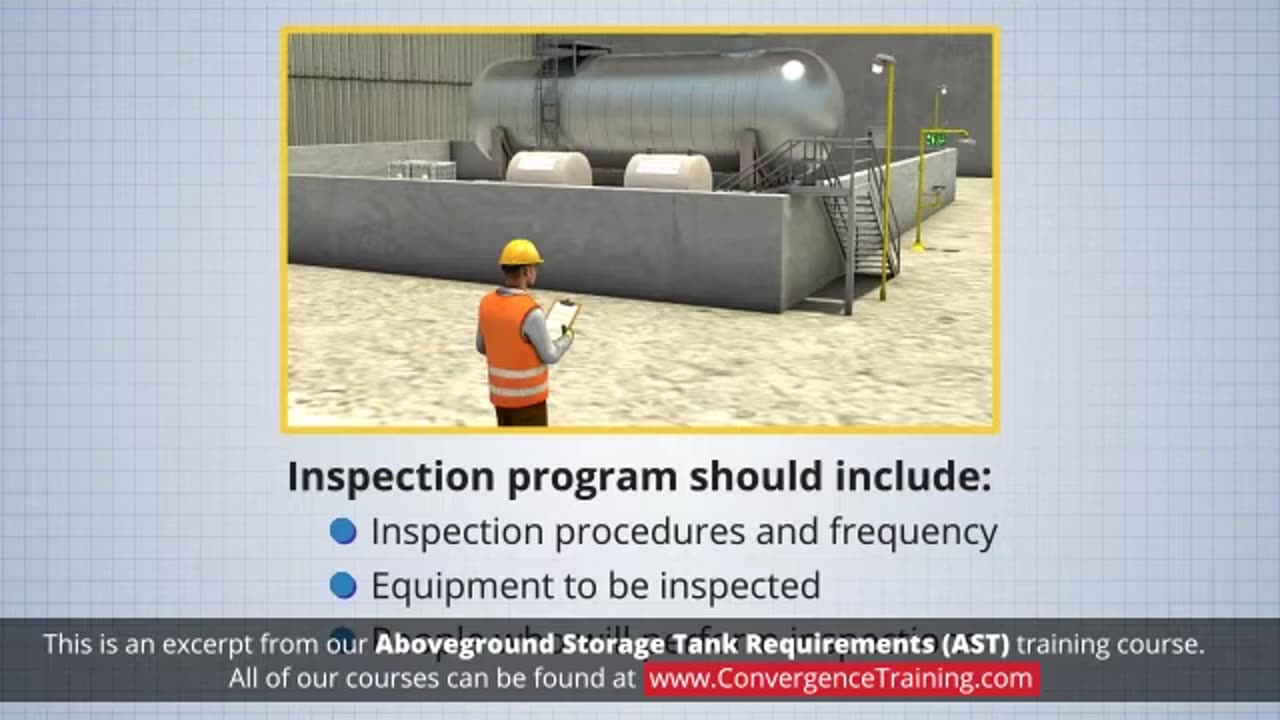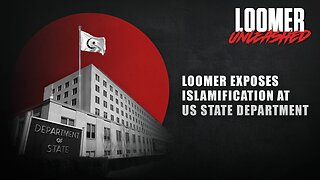Premium Only Content

Aboveground Storage Tank Requirements (AST) Training
### **Aboveground Storage Tank (AST) Requirements Training Guide**
**Objective**: Provide employees with the knowledge and skills necessary to safely manage and operate Aboveground Storage Tanks (ASTs) in compliance with environmental regulations and safety standards.
---
### **1. Introduction to Aboveground Storage Tanks (ASTs)**
- **Definition**:
Aboveground Storage Tanks (ASTs) are containers used for storing liquids such as fuels, chemicals, or oils. These tanks are installed above the ground and are subject to various safety and environmental regulations.
- **Common Liquids Stored in ASTs**:
- Petroleum products (e.g., gasoline, diesel).
- Chemicals (e.g., solvents, acids).
- Water and wastewater.
---
### **2. Regulatory Framework and Standards**
#### **Federal Regulations**
- **Environmental Protection Agency (EPA)**:
- **40 CFR Part 112**: Regulates the Oil Spill Prevention, Control, and Countermeasure (SPCC) plan for ASTs.
- **40 CFR Part 63**: Regulates hazardous air pollutants (HAPs) and other emissions from ASTs in certain industries.
- **Occupational Safety and Health Administration (OSHA)**:
- **29 CFR 1910**: Establishes general industry safety standards for managing flammable liquids and hazardous chemicals.
- **National Fire Protection Association (NFPA)**:
- **NFPA 30**: Flammable and Combustible Liquids Code provides guidelines for the design, installation, and operation of ASTs.
- **NFPA 704**: Standard for labeling hazardous materials, including substances stored in ASTs.
#### **State and Local Regulations**
- Local authorities may have additional requirements for tank design, maintenance, and spill prevention.
- Compliance with state-specific spill response regulations is essential.
---
### **3. AST Design and Construction Requirements**
#### **Tank Material and Construction**
- **Corrosion-Resistant Materials**:
Tanks must be made from materials resistant to corrosion, such as steel or fiberglass, depending on the substance stored.
- **Secondary Containment**:
ASTs must have secondary containment systems (e.g., dikes, berms) that can contain 110% of the tank’s capacity to prevent spills from spreading.
- **Leak Detection**:
Tanks should be equipped with systems to detect leaks, including automatic tank gauges or manual inspection systems.
- **Vents and Overfill Prevention**:
Tanks must have proper venting systems to avoid pressure buildup. Overfill prevention mechanisms should be in place to avoid spills during filling.
- **Tank Foundations**:
ASTs should be securely anchored and placed on a stable foundation to prevent movement, which could cause damage or leaks.
---
### **4. AST Inspection and Maintenance**
#### **Regular Inspections**
- **Visual Inspections**:
Check for signs of rust, cracks, and corrosion on the tank surface, pipes, valves, and other parts.
- **Leak Detection**:
Regularly monitor for any visible leaks or abnormal odors near the tank and its components.
- **Tank Testing**:
Perform periodic testing for internal corrosion, structural integrity, and the functionality of valves, vents, and overfill prevention equipment.
- **Maintenance Records**:
Keep detailed records of inspections, maintenance, repairs, and any issues related to the tank’s integrity.
#### **Cleaning and Repairs**
- **Scheduled Cleaning**:
Clean tanks periodically to prevent the buildup of residues or chemicals that could cause corrosion or block systems.
- **Repairs**:
Any damage or deterioration should be addressed immediately, with tanks being decommissioned if needed until repairs are completed.
---
### **5. Spill Prevention and Response**
#### **Spill Prevention Measures**
- **Secondary Containment**:
Ensure proper containment to handle spills, including the use of double-walled tanks or earthen berms.
- **Proper Tank Filling Procedures**:
Follow procedures to avoid overfills, such as having automatic shut-off valves and alarms.
- **Inspection of Valves and Connections**:
Check for secure fittings on tank valves, lines, and connections to prevent leaks.
#### **Spill Response**
- **Spill Kits and Equipment**:
Maintain spill response equipment such as absorbent materials, booms, and pumps.
- **Emergency Response Plan (ERP)**:
Develop and implement an emergency response plan for managing spills, including the steps for containment, reporting, and cleanup.
- **Training Employees**:
Regularly train staff on emergency procedures, proper use of spill response tools, and reporting mechanisms.
---
### **6. Tank Labeling and Signage**
- **Warning Labels**:
Each AST must have appropriate warning signs indicating the contents, hazards, and emergency contact information.
- **Emergency Contact Information**:
Clearly display emergency contact numbers for spill response and hazardous material management.
- **NFPA Labeling**:
Use NFPA 704 labeling to indicate the level of hazard (health, flammability, instability) associated with the tank’s contents.
---
### **7. Documentation and Recordkeeping**
- **SPCC Plan**:
Maintain an up-to-date Oil Spill Prevention, Control, and Countermeasure (SPCC) plan as required by EPA regulations.
- **Inspection Logs**:
Keep detailed records of inspections, maintenance, and repairs for all ASTs.
- **Training Logs**:
Document employee training on tank safety procedures, spill response, and other relevant topics.
---
### **8. Emergency Shutdown and Evacuation Procedures**
- **Emergency Shutdown**:
Train employees to shut down tank systems in case of an emergency, such as a fire or significant leak.
- **Evacuation Plan**:
Develop and implement evacuation procedures in the event of a spill, fire, or other hazardous conditions.
---
### **9. Key Takeaways**
- ASTs require proper design, construction, and maintenance to prevent leaks and spills.
- Regular inspections and maintenance are essential for safe tank operation.
- Secondary containment and emergency response plans are critical for mitigating environmental and safety risks.
- Compliance with local, state, and federal regulations is necessary to avoid penalties and ensure the safety of workers and the environment.
---
Would you like this guide formatted as a presentation, checklist, or training manual? I can also provide templates for inspection logs or emergency response plans if needed.
-
 20:24
20:24
HSESafetyInformation
6 months agoKABULI PULAO RECIPE - Original 40+ KG Afghani Meat Pulau Prepared - Street Food Qabili Plav Recipe_2
35 -
 2:03:46
2:03:46
Inverted World Live
5 hours agoHaunted Dolls Hack Amazon Alexa | Ep. 98
82K2 -
 3:09:53
3:09:53
Laura Loomer
5 hours agoEP140: Loomer EXPOSES Islamification At US State Department
20.2K12 -
 3:05:00
3:05:00
TimcastIRL
5 hours agoTrump Floats Accepting 600,000 Chinese Student Visas, MAGA Uproar | Timcast IRL
182K114 -
 8:44:47
8:44:47
SpartakusLIVE
10 hours ago$20,000 Hide and Seek Tourney w/ Stonemountain64 || #1 Rat wins the BIG CHEESE
57K -
 2:34:02
2:34:02
Barry Cunningham
6 hours agoLISA COOK | ADAM SCHIFF | LETITIA JAMES | ARE THEY BEING SACRIFICED BY THE DEEP STATE?
79.6K52 -
 1:36:19
1:36:19
Flyover Conservatives
14 hours agoOnly 17% of Millennials Hit These 5 Adult Milestones—Why?; What If Childhood Trauma Is Behind Your Health Problems? - Dr. Troy Spurrill | FOC Show
26.5K3 -
 4:49:04
4:49:04
HogansAlleyHero
16 hours ago💥CHASING DOPAMINE💥✅TRUMP SAYS BATTLEFIELD IS THE BEST✅
33.9K2 -
 1:57:40
1:57:40
MattMorseTV
7 hours ago $10.57 earned🔴Trump just SHATTERED the PROJECTIONS.🔴
48.9K46 -
 2:32:19
2:32:19
megimu32
5 hours agoOTS: From Star Search to Superstardom
34.9K4